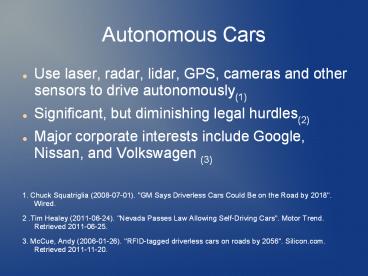Autonomous Cars - PowerPoint PPT Presentation
Title:
Autonomous Cars
Description:
Autonomous Cars Use laser, radar, lidar, GPS, cameras and other sensors to drive autonomously(1) ... Autonomous car technology is banned altogether. – PowerPoint PPT presentation
Number of Views:5171
Avg rating:3.0/5.0
Title: Autonomous Cars
1
Autonomous Cars
- Use laser, radar, lidar, GPS, cameras and other
sensors to drive autonomously(1) - Significant, but diminishing legal hurdles(2)
- Major corporate interests include Google, Nissan,
and Volkswagen (3) - 1. Chuck Squatriglia (2008-07-01). "GM Says
Driverless Cars Could Be on the Road by 2018".
Wired. - 2 .Tim Healey (2011-06-24). "Nevada Passes Law
Allowing Self-Driving Cars". Motor Trend.
Retrieved 2011-06-25. - 3. McCue, Andy (2006-01-26). "RFID-tagged
driverless cars on roads by 2056". Silicon.com.
Retrieved 2011-11-20.
2
8-Step Ethical Decision Analysis
- 1. The issue is whether autonomous cars should be
allowed on public roads. - 2. The interested parties are the corporations
developing technology who would like to see it
used profitably, consumers who would like to see
a safe implementation, and governments who would
like to have a controlled and regulated
implementation if any. - 3
- a) Unregulated usage of automation. This freedom
could allow for a booming market in the best
case, but could result in unsafe roads and
unsatisfactory liability for accidents. This
worst case is not acceptable.
3
8-Step Ethical Decision Analysis
- b). Autonomous car technology is banned
altogether. In the best case, this would protect
people from a potentially dangerous technology,
and in its worst case it would stifle a
potentially useful new technology and the safety
it could bring. This is acceptable but not
ideal. - c). In a compromise, autonomous driving
technology could be developed in a tightly
monitored and regulated manner. In the best case
this would allow autonomous cars to be developed
safely, and in the worst case could potentially
allow dangerous autonomous cars on the road.
This compromise is acceptable.
4
8-Step Ethical Decision Analysis
- 4).
- a) I would be willing for everyone to be
permitted to use this solution because it would
allow developers freedom to explore new
technology while protecting consumers from
potential danger - b) This solution does treat people as ends rather
than just means - 5).
- a) This solution is in accord with what is
natural because it allows for exploration while
protecting bystanders - b) This solution is balanced between excess and
deficiency
5
8-Step Ethical Decision Analysis
- 6)
- a) There would be a majority agreement that this
is the most efficient means to the end, because
it protects everyone's interests - b). This will produce the greatest good by
protecting citizens while allowing corporations
to invest in and develop new technology - 7)
- a) I do feel committed to this solution in my own
conscience - b) I chose this solution free of influence from
others
6
8-Step Ethical Decision Analysis
- 8) The solution is primarily a pragmatic one
because it uses a compromise to produce a
feasible solution to provide the greatest good to
the greatest number of people.
7
Application of ACM Code of Ethics
- Abridged application of code
- Important sections to this issue
- 1.1) Contributes to society by improving road
safety - 1.2) Avoids harm to others with strict regulation
and safety controls - 1.3/4) Needs to keep data private to maintain
ethical position































